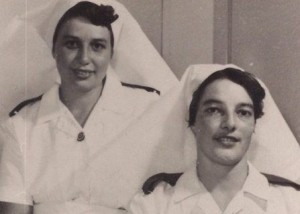
Radium Hill pays tribute to its outback nurses
 Sr Dulcie Gibson and Connie Savage in 1957-8The nurses who worked at the Australian Inland Mission (AIM) hospital in Radium Hill more than 50 years ago were celebrated as “unsung heroes” at a special Centenary display this month.
Sr Dulcie Gibson and Connie Savage in 1957-8The nurses who worked at the Australian Inland Mission (AIM) hospital in Radium Hill more than 50 years ago were celebrated as “unsung heroes” at a special Centenary display this month.
A collection of historical photos and records went on display at the beginning of May at the Radium Hill Historical Society’s museum, based on Tikalina Station, 25 km past Olary towards Broken Hill.
Titled “What a job: Outback nursing in the 1950s”, the display paid tribute to the work of the AIM in Radium Hill and the women who worked at the hospital from 1953 until 1961.
This year Frontier Services celebrates the 100-year anniversary of the establishment of the AIM and the continuing work to support people across remote Australia.
Radium Hill, in the remote northeast of South Australia, was the birthplace of uranium mining in Australia. Intensive mining began in 1952. Shafts were sunk and a processing mill built, along with a town to accommodate up to 1200 people. During its main period of production between 1954 and 1961, the mine produced nearly 1 million tonnes of davidite-bearing ore.
In 1953, the Australian Inland Mission established the Radium Hill Nursing Home, providing health care services to the miners and their families. The nursing sisters lived in the adjoining house and were on call 24/7. During its operation, 117 babies were delivered at the AIM Nursing Home.
President of the Radium Hill Historical Society Kevin Kakoschke said the workload of the sisters and their commitment to the community was incredible.
“In 1958, the AIM hospital, staffed by Sisters Dulcie Gibson and Connie Savage, was the busiest AIM Hospital in Australia at the time,” he said. “The Hospital nursed 153 inpatients for a total of 622 patient days. They also tended 3,591 outpatients who received 10,469 treatments. In that same year, they delivered 18 babies who didn’t sleep throughout the night and neither did they, on call 24/7!”
Mr Kakoschke experienced the care of the AIM nurses first-hand, having worked in the mines from 1953-1961. His brother was taken to the hospital after a serious mine explosion.
“The Flying Doctor, Dr Huxtable, and the two nursing Sisters spent the whole night probing his shredded and shattered body for shrapnel and removing them before stitching him up.”
“I have heard the stories, I was a patient and my family were treated by the AIM nurses. Nothing was too much for them. They were the unsung heroes of Radium Hill.”
The mine closed in December 1961 and by the end of 1963, 165 houses plus cubicles and mining structures had gone, as had the residents who were given new opportunities in other mines and communities both within Australia and overseas.
The AIM Radium Hill Nursing Home closed in 1962, allowing the AIM to move on to the next community in need.
The Historical Society’s display includes 23 photographs, the names of everyone born at the hospital and the names of the nursing sisters who worked there.
It is hoped the display, originally planned for the month of May, will continue throughout the year.
